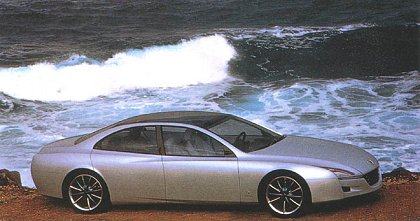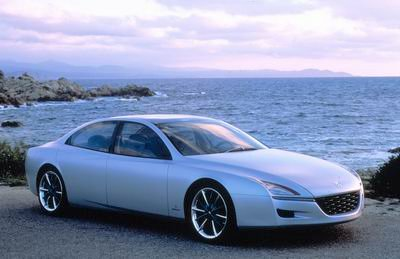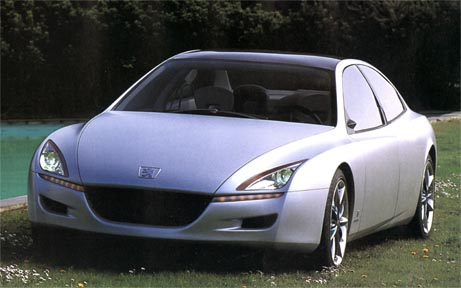1997 Peugeot Nautilus
- Story Cars

- Oct 24, 2021
- 5 min read
The Nautilus is an exciting study of form meant to interpret the theme of large and high-class sporty sedans in purely stylistic terms. Realized in homage to the collaboration with Peugeot is a balance of sportiness, luxury, and innovation in a car with a lively personality that blended a passion for the Gran Turismo with the natural "importance" of a status symbol. If a car will mark the 1997 Geneva Motor Show for setting a new styling trend, this is the Pininfarina Nautilus. A very exotic four-door, four-seater, sport sedan with great charisma, a strong design character, and a unique style.
With plenty of details that perfectly enhance its shape and highlights. The silk, almost matt, silver-colored paint to start with. A pure styling exercise that Lorenzo Ramaciotti, general manager of the company's "Studi e Ricerche" think thank, felt is needed at this time of uncertain transition from the abused "bio-design" age into a new "design age." As we had an opportunity to report on a previous occasion, Ford's designers saw this "hole" coming. They were first to take action, delivering what they call their "new edge" design philosophy.
"After a phase through which it was difficult not to adjust to the bio-design trend, car design hasn't any strong reference, and there is a great freedom to look for new and individual aesthetic proposal," comments Ramaciotti. Nautilus is born from this newly found freedom. Unlike most of Pininfarina's recent research cars, it is more a dream car than a "concept car," such as the Ethos series, "Argento Vivo," Sing and Song, and Eta Beta prototypes.
Listening to Ramaciotti, one understands that the design objective was to answer a question that may not be fundamental but is undoubtedly intriguing: must the stately flagships of the King Of The Hill be conservative and orthodox limousines, with classic, neutral and rational style or can they have the allure and style of lively sculpture. Capable of stimulating emotions and speaking of dynamic elegance? If the answer is "yes," then one might have found a way to challenge the German Three's German makers' domination (with few exceptions, such as Jaguar).
In recent years, French makers believed to have found a way; they did not make it with the Renault Safrane, the Citroen XM, and the Peugeot 605. It doesn't take much to understand that one of the key reasons was the inadequacy of their style, not just nation, company, and product image. But the lack of design charisma. What Audi has eventually achieved with its latest A4 and A6, after a long series of failures (including their Audi 100), shows the difference and what needs to be done.
Pininfarina's answer to the "if" and "how" the Germans can be successfully challenged is very encouraging and, as far as its style goes, it is convincing. With some exaggeration, we would say that they oppose a generation of Carl Lewis to an old and well-established class of Sumo players. The body style of Nautilus is new, solid, elegant, and expresses a strong sense of quality. It is original, even though the subject of a "luxury, high performance, sport sedan" was tackled and superbly developed by the 12 cylinders 1980 Ferrari Pinin project. That 1980 Pinin and this 1997 Nautilus share the classic architecture of a four-door, four-seater sedan and the overall dimensions of a large car but speak two very different styling languages. Other major differences include the chassis and powertrain. Nautilus is a running prototype built over the modified front-wheel drive Peugeot platform and is powered by the brand new 24 valves 3.0 liter V 6 French engine.
This unique running prototype is impressive for its stance and style: it is significantly bigger than the Ferrari Pinin itself. It is 1948 mm. wide with 1650 mm. wide track (1640 at the front), and its huge 19" Bridgestone tires fitted on 9.5" wide rims are laid down on the ground to grant a 2,950 mm long wheelbase. The overall length is just 10mm. Shorter of the 5 meters. Wheelbase and width had to be massive because of the Nautilus's relatively low 1355 mm height and its small, curvy, and sloping roof. The silhouette is, no question about it, sleek and very dynamic, yet the cabin is very comfortable.
Once the proportions have been set, the overall sculpture has been modeled to convey a strong sporty image. How do they do it? The car itself tells it all. Starting with the long bonnet, which central part dramatically hangs over the front axle as to bring forwards the Peugeot symbol as to announce the arrival of a king.
On its turn, the lower part of the body sides, introduces a new way of holding together large steel panels in a very elegant and three-dimensional form originated by two overlapping sculptured volumes. Pininfarina designers first applied a very innovative approach to form shaping with the 1989 Ferrari Mythos Barchetta. With the difference that here the car is a four-door and the waistline is fairly high.
This area is of great interest not only for its "structured shape," its crisp, headlight, and its physical dimensions but also because it does with no doors (integrated into the pillars, just above the waistline), without conventional rearview mirrors (replaced by a video camera). The doors take significant importance as they wrap the lower structure. To provide a strong feeling of protection (that looks real) to the passengers and limit the "fragile" but heavy glass area. The risk here is to reduce the sense of lightness inside the car (as delivered by the Audi TT), but this does not appear to be the case. Courtesy of the roof-colored glass roof.
The rear of the Nautilus is also beautiful and exciting. Here one cannot but appreciate that the tail is a nice thing to look at to the advantage of those driving behind the car (actually seeing the rear for much longer than those crossing it). We leave pictures and captions to describe the car in detail for both the exterior and interior design. Here. we have to stress the reasons for the rather peculiar combination of material and colors for the cabin, which serves different purposes but primarily that of "communications."
We are not just referring to the TLC (telecommunication) equipment fitted (or to be) inside the car but primarily to stress the designer's "user suggestions."
According to Ramaciotti, "the concept that inspired the passenger compartment and guided the design of the interior refers to the type of use that a car of its class can be earmarked for: a sports car driven by its owner, or a chauffeur-driven limousine." For this reason, the front passenger area is very different from the one dedicated to rear passengers. The front passenger seat is sportier, while the rear seat tends to emphasize the living room aspect. Also, the instrumentation can be delivered in two different modes: digital for a more comfortable driving style, analog for a sportier style.
At first sight, the concept sounds intriguing and attractive, but in the reality of the Nautilus, the outcome is not fully convincing. There is a lack of harmony inside the cabin and hence a feeling of disorientation. In a few words a wonderful opportunity for designers to refine a concept and work in an area where there still is a lot of room for improvements.
Is this a merciless critic? Not at all. Just the rational observation of a research project that, as such, finds out about solutions or, on the contrary, shows that certain ways are not as good (or have not been implemented as well) as originally intended and anticipated when the project was launched. Probably the best performance of Nautilus is that if fully succeed in being that poetic automobile, reflecting the emotional and optimistic, romantic science described in his books by Jules Verne, the French author who dreamed and described a future that has become true. The question now is whether the Nautilus by Pininfarina will also become a reality in a not too distant future.
Sources: pininfarina spa.; www.conceptcars.it













































Comments